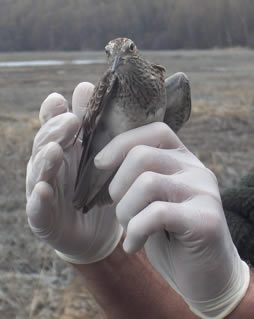Scientists Try to Unravel How Lethal Cholera Swept Northern Eider Ducks
CanWest News Service
1 Apr 2007
M Munro
Area: Southhampton Island, Canada
The scene was gruesome as a lethal disease swept through one of the largest and most carefully monitored bird colonies in the Canadian Arctic last year. Thousands of northern eider ducks went into convulsions and collapsed. "Others died with their eyes open, sitting there on the nest like they were still alive," says biologist Grant Gilchrist of the Canadian Wildlife Service, whose field crew watched in awe and horror as avian cholera decimated the colony.
Located on Nunavut's Southampton Island in northern Hudson Bay, it is the largest colony of northern eiders in the world. When it was over more than 3,500 birds - 75 per cent of the colony's nesting females - had died. Rigor mortis set in, "and the gulls, opportunists that they are, learned to walk through the colony and poke every nesting bird. If it didn't move, they knew the eider was dead," says Gilchrist.
 U OF M Awarded $22.5 million NIH Contract to Study Avian Influenza [Press Release]
U OF M Awarded $22.5 million NIH Contract to Study Avian Influenza [Press Release]EurekAlert
2 Apr 2007
Area: Minnesota, USA
Photo Courtesy of The Alaska Report
University to establish Center of Excellence for Influenza Research and Surveillance
The National Institute of Allergy and Infectious Disease (NIAID), part of the National Institutes of Health (NIH), today named the University of Minnesota as one of six sites across the country that will establish a Center of Excellence for Influenza Research and Surveillance. The Minnesota NIH/NIAID Center of Excellence for Influenza Research and Surveillance (MCEIRS) will receive $22.5 million over seven years to focus on disease and virologic surveillance of avian influenza viruses, providing the federal government with useful information and public health strategies for controlling the impact of an influenza pandemic.
“The Center of Excellence established at the U of M will work to rapidly identify and characterize influenza viruses that have pandemic potential by monitoring domestic and international wild bird, poultry, and swine populations,” said Marguerite Pappaioanou, D.V.M., Ph.D., principal investigator and professor of infectious disease and epidemiology at the University of Minnesota School of Public Health. “The center will be prepared to respond to research and public health needs in a time of increasing concern over the possibility of pandemic flu.”
 Deer at Risk From Chronic Wasting Disease
Deer at Risk From Chronic Wasting DiseaseRocky Mountain Outlook
2 Apr 2007
R Alexander
Image courtesy of The Free Lance Star
Preliminary results from a study looking at chronic wasting disease in mule deer suggests the Rocky Mountains may not be a sufficient barrier to prevent mule deer in this region from contracting the disease. Stephanie Nakada, a masters student at the University of Alberta, said her research to date has shown no known barrier exists in natural mule deer movement. She has also found, so far, little genetic difference between sub-populations.
“If a diseased migrant entered the population, we could expect that all individuals could be infected,” Nakada said during a presentation of her work as part of the Wildlife Society Conference 2007 held in Canmore at the Radisson Hotel and Conference Centre March 18 to 21. In wild mule deer, the first case of chronic wasting disease, a neurological disease that causes progressive weight loss leading to death, was documented in Colorado in 1967.
Related Articles
>>>Chronic Wasting Disease a Threat to Deer
>>> Chronic Wasting Spreads (SCROLL DOWN)
Pennsylvania Sounds Alarm Over Wild Hogs
The Morning Call
1 Apr 2007
C Berg
Area: Pennsylvania, USA
State and federal officials are sounding the alarm over Pennsylvania's rapidly growing population of wild hogs, highly aggressive and destructive animals that pose serious threats to farms and wildlife. A government investigation launched in the fall shows the state might have as many as 3,000 of the tusked beasts - a number far greater than officials first believed. The U.S. Department of Agriculture has evidence of at least 300 hogs killed by hunters this past winter alone.
"What's being taken (by hunters) is just scratching the surface of what's there," said Harris Glass, state director of USDA Wildlife Services. When USDA and the Pennsylvania Department of Agriculture launched their $60,000 wild hog study in November, officials thought they were dealing with perhaps several hundred animals. They have since determined at least five counties - Bedford, Bradford, Butler, Cambria and Tioga - have significant breeding populations of hogs.
Job Postings
Postdoctoral position
Montana State University Bozeman
USGS National Wildlife Health Center, Madison, Wisconsin
A postdoctoral position is available to investigate the persistence and fate of chronic wasting disease and other prions in the environment and factors that may influence natural degradation of the infectious isoform of prion proteins. Work will be conducted primarily at the National Wildlife Health Center in Madison, Wisconsin, but also at Montana State University in Bozeman, Montana. The successful applicant should have a Ph.D. or equivalent, some grant writing experience, and a proven publication record. Experience in environmental microbiology or biochemistry is preferred. A competitive salary and benefits package will be offered. To apply, email (rbessen@montana.edu) or send letter of application, curriculum vitae, and the names of three references to:
Dr. Richard A. Bessen, Veterinary Molecular Biology, P.O. Box 173610, Montana State University, Bozeman, Montana 59717. Equal Opportunity Employer.
Journal Articles of Interest
Rapid and Highly Sensitive Pathotyping of Avian Influenza A H5N1 Virus by Using Real-time Reverse Transcription-PCR. [online abstract only]
J Clin Microbiol. 2007 Feb;45(2):600-3. Epub 2006 Dec 20.
B Hoffmann et al
Animal-based National Surveillance for Zoonotic Disease: Quality, Limitations, and Implications of a Model System for Monitoring Rabies. [online abstract only]
Prev Vet Med. 2007 Mar 17;78(3-4):246-61. Epub 2006 Nov 28.
JE Childs et al





No comments:
Post a Comment